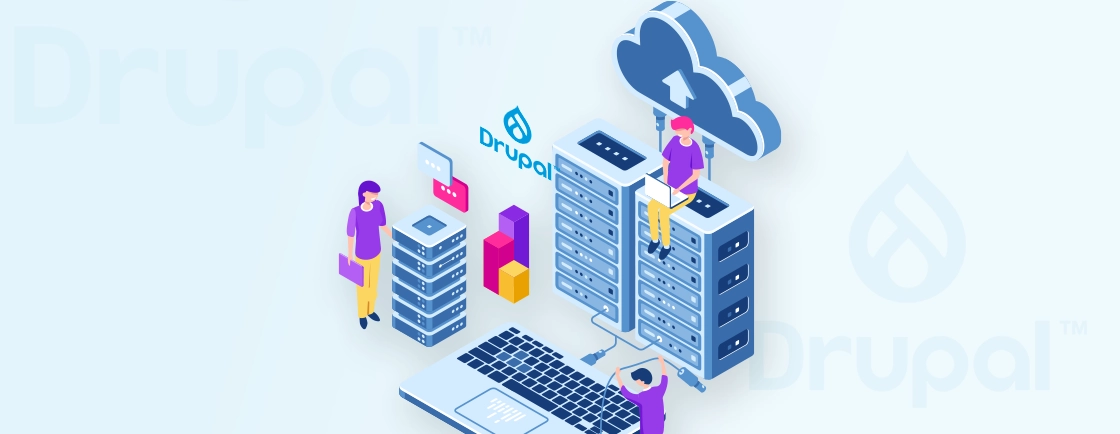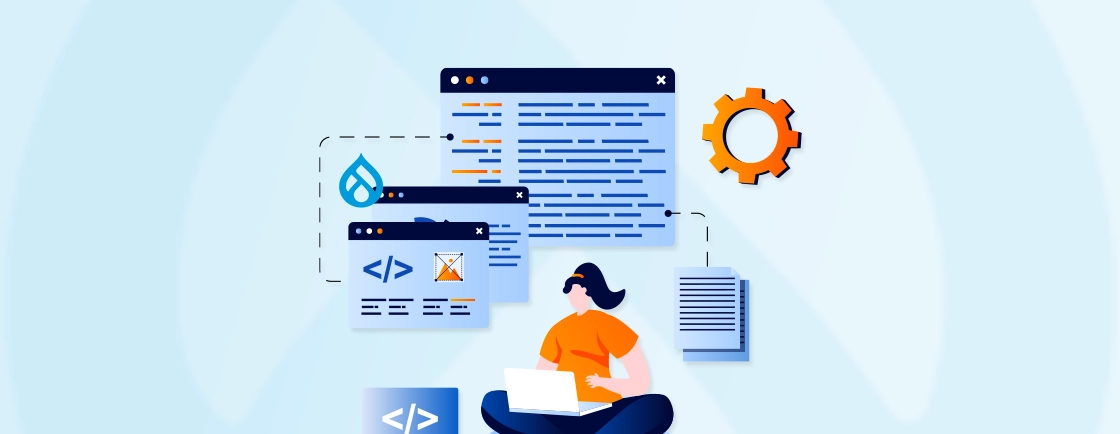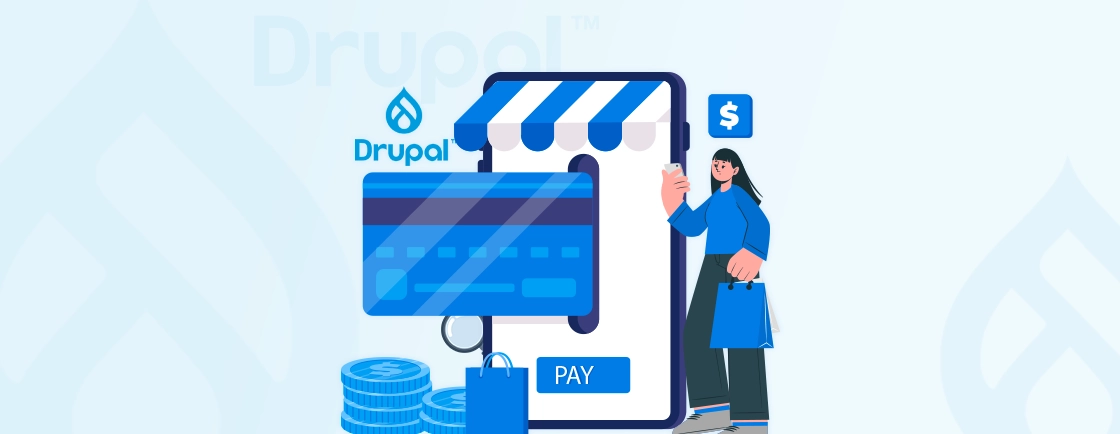Table of Contents
Traditional Drupal excels at creating and managing content, but its presentation options can feel limiting. That’s where Headless Drupal comes in. It separates the content creation and management (Drupal’s expertise) from the way it’s presented (what the users see).
Headless Drupal leverages APIs (Application Programming Interfaces) to act as a content hub. Content creators use the familiar Drupal interface to build and manage content, while developers design the website’s front-end using their preferred framework. That allows for better scalability and flexibility.
In this blog, you’ll learn all about Headless Drupal and its benefits. And I will show how our Drupal development company uses this approach for our project. Let’s begin.
What is Headless Drupal?
Headless Drupal, also known as decoupled Drupal, is a way of using the Drupal CMS solely as a backend content repository and administrative interface. And the frontend presentation layer is built and managed separately using technologies like JavaScript frameworks.
Decoupling allows the backend to store and manage content operations that are independent of the front end where the user interface takes place. So the developers can flexibly choose the right fit for the frontend and Drupal for the backend. It not only streamlines the process, but also reduces loading time and enhances security.
Headless Drupal serves as a guide to creating dynamic and interactive websites that can evolve the digital world.
Difference Between Traditional Drupal and Headless Drupal
| Feature | Traditional Drupal | Headless Drupal |
|---|---|---|
| Architecture | Frontend and Backend is coupled together | Decoupled – Separate backend (Drupal) and frontend frameworks |
| Frontend Flexibility | Limited, tightly coupled to Drupal’s frontend | High, frontend can be built using any technology |
| Content Delivery | Via Drupal’s built-in rendering | Through APIs, content can be consumed by any app |
| Frontend Technology | Relies on Drupal’s theming system | Uses modern frontend frameworks (React, Angular, etc.) |
| Performance | Can be slower due to monolithic architecture | Can be faster, especially for highly dynamic sites |
| Scalability | Limited scalability due to monolithic nature | Highly scalable, can handle heavy traffic |
| Maintenance | Updates can affect frontend and backend | Backend updates don’t affect frontend |
| SEO | Built-in SEO features | Requires additional effort for SEO optimization |
| Security | Vulnerabilities can affect both frontend and backend | Frontend and backend are decoupled, reducing security risks |
| Cost | Development and maintenance costs can be higher | Development costs can be lower, but may require more expertise |
Traditional Drupal is ideal for projects with a focus on web experiences with built-in functionalities and a friendly UI. But Headless drupal is perfect for projects demanding maximum flexibility and omnichannel content delivery.
Why Use Headless Drupal?
Headless Drupal works on a decoupled architecture. That means you can choose different
Decoupling frontend and backend allows developers to create dynamic and functional websites with faster loading time and is highly scalable. The separation offers great flexibility in design, as frontend techs like React or Angular can be easily integrated into backend services.
Here are a few key benefits of Headless Drupal:
Enhanced Flexibility
Headless Drupal separates the content management system (Drupal) from the frontend presentation layer. This allows developers to choose the most suitable frontend technology (React, Angular, etc.) for each project. This flexibility empowers developers to create highly customized and optimal user experiences tailored to meet your needs.
Improved Scalability
The decoupled architecture enables independent scaling of the backend (Drupal) and frontend. You can scale the Drupal backend to handle increasing content volume, while the lightweight frontend can be optimized for faster loading times. This ensures your website remains performant as your content and user base grow.
Omnichannel Content Delivery
Content created in Drupal can be easily delivered to various platforms beyond just a traditional website. Headless Drupal empowers you to leverage APIs to seamlessly integrate your content with mobile apps and single-page applications (SPAs). That lets you create a unified and consistent experience across all touchpoints.
Streamlined Development
Decoupling content management from presentation is key for a streamlined process. So, backend developers can focus on building and managing secure content and frontend developers can work on user interface. This division can potentially streamline the development process
Enhanced Security
The separation of frontend and backend layer (where sensitive content is stored) makes it a secure option. A potential vulnerability in the front might not directly compromise your core data. Additionally, Drupal itself is known for its robust security features and regular updates.
With this, we can see that decoupling enables easy integrations with various frontend technologies, for better user experience and higher engagement. Quicker development and streamlined processes make it a great option for Drupal development services.
Are There Any Limitations with Headless Drupal?
Like any other development approach, alongside its advantages, headless Drupal has its limitations. Here are a few of them:
Increased Development Complexity
Developers need expertise in both Drupal for content management and a separate frontend framework to build the user interface. This can demand a larger team with diverse skill sets of developers for fast-paced project development.
Potential for Higher Costs
The additional development complexity can result in higher costs. Hiring Drupal developers with specialized skills in both Drupal and separate frontend frameworks can be more expensive compared to a traditional Drupal setup.
Content Preview Limitations
Viewing content before publishing can be challenging in Headless Drupal. It may not be as seamless as the built-in preview functionality offered by traditional Drupal. This can slow content creation workflows and quality assurance processes.
Increased Maintenance Needs
Both the Drupal backend and the chosen frontend framework require timely maintenance. That includes security updates, bug fixes, and potential compatibility considerations when new framework versions are released. These update maintenance across two separate systems can add to increased overall needs.
The decoupled approach makes content management more complex than traditional CMS systems. But with the right Drupal experts, you can have the best results.
How Does Headless Drupal Work?
In Headless Drupal, this CMS manages content independently from the frontend interface (controlled by a different technology). It uses an API-first approach to bridge communication between backend and frontend components. Here’s a breakdown of how it works:
- Content Creation: Content editors use the familiar Drupal interface to create, edit, and manage content (text, images, videos, etc.). This content is stored in the Drupal database.
- API Exposure: Drupal exposes the content through APIs (Application Programming Interfaces). These APIs act like messengers, allowing other applications to request and retrieve specific pieces of content.
- Frontend Development: Developers build the website’s frontend using a separate framework like React, Vue.js, or Angular. This frontend application is responsible for the website’s look, feel, and interactivity.
- Content Delivery: When a user visits the website, the frontend application makes requests to the Drupal APIs to fetch the necessary content. The APIs deliver the requested content data (usually in JSON format) to the frontend application.
- Presentation: The frontend application receives the content data and uses it to build and display the webpages for the user.
Overall, Headless Drupal offers a powerful and flexible approach for content management. But you will need a more technical skillset to implement it effectively.
How to Choose the Best Frontend Frameworks for Headless Drupal?
Selecting the ideal frontend frameworks for your Headless Drupal project requires careful consideration of your specific needs and priorities. Here’s a breakdown of factors to consider before choosing a frontend framework.
- Focus on interactivity: If your project demands a highly interactive user experience with dynamic content updates, frameworks like React or Vue.js can be the right fit.
- Prioritize speed and simplicity: For static websites with minimal interactivity, a static site generator like Gatsby.js or Hugo could be a great choice due to their lightning-fast performance.
- Developer Expertise: Take into consideration frameworks that are already familiar to developers, resulting in an efficient development process.
- Community and Support: Choose frameworks with a large active community. This provides access to valuable resources, tutorials, and support in case of any technical issues.
The most popular frontend frameworks for Headless Drupal include Angular, React, and Vue. But make sure you do a thorough research before selecting any of the above-mentioned options.
As for the backend part of the architecture, you will use Drupal. Its robust content management capabilities, extensive module library, and strong security features make it an ideal choice for managing your website’s content.
FAQs About Headless Drupal
Is Headless Drupal more secure?
Potentially yes, separating the content and presentation layer makes it a secure option. However, maintaining security requires updates for both Drupal backend and frontend frameworks is crucial.
Can Headless Drupal integrate with other platforms?
Yes, you can use Drupal’s robust APIs to integrate content with various platforms, including e-commerce solutions, marketing automation tools, and even social media platforms.
Can I learn Headless Drupal with no prior experience?
Yes you can, but some coding knowledge is helpful, for beginners tutorials and resources are available to start with that can be a solid foundation for being a Drupal developer.
Conclusion
In Headless Drupal, you use the Drupal CMS solely as backend content repository and interface, while the frontend layer is independent. Basically, it exposes its content through APIs (typically RESTful or GraphQL) which can be consumed by frontend applications or websites.
The Headless Drupal workflow is split into 5 stages:
- Content creation
- API exposure
- Frontend development
- Content delivery
- Presentation
Headless Drupal helps create modern, highly performant, and flexible digital experiences. So if you want to implement this approach and need personalized support of experts, opt for our Drupal consulting services now!





